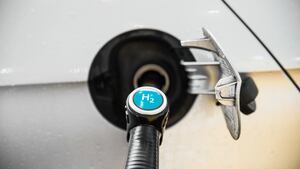Transitioning away from fossil fuels will mean relying on alternative sources to power our machinery, technology, homes, and vehicles. In many ways, hydrogen-based energy seems like our best bet: It can be made from water, a naturally abundant resource, and its uses run the gamut from agriculture to transportation. But right now, clean hydrogen production relies on a process called electrolysis that splits water into its atomic components of hydrogen and oxygen.
Electrolysis is limited by access to freshwater. According to a new study published Tuesday in Nature Communications, more than one-third of the planet’s land is arid or semi-arid, and home to about 20 percent of the world’s population. Freshwater is not easily available in these parts, and it’s only becoming more and more scarce. Water stress increased in most parts of the world between 2008 and 2018, according to a 2021 U.N. report on water.
But the authors of that new paper, hailing mainly from the University of Melbourne, think they have just come up with a potential solution to carrying out electrolysis in water-stressed areas: a new method they’ve tested out that captures water and produces hydrogen from thin air—literally. We could soon have a viable way of sustainably producing hydrogen without consuming valuable freshwater reserves—which could enable communities to decarbonize their energy production without compromising the water needs of their populations.
The new method relies on a porous foam made from glass that is soaked in a moisture-wicking electrolyte and absorbs water from the air. Electricity from a renewable energy source like solar panels or a wind turbine can be used to split the absorbed water into oxygen, which is released, and hydrogen, which is collected in a chamber.
After testing the stability and energy inputs of their system, the researchers stacked five of their collectors on top of one another to form a tower, and hooked the stack up to a solar panel. They measured the tower’s hydrogen production over the course of two days where it was stationed on the campus of the University of Melbourne and found that it reliably produced hydrogen, 1,490 milliliters on the first day and 1,188 on the second day, when weather conditions were poorer.
The results are pretty encouraging, though by no means is this method ready for large-scale practical use. An electric vehicle, for instance, holds about five kilograms of liquid hydrogen in its tank—orders of magnitude more than the researchers were able to produce. Quite a bit more work is needed to show how this system can be scaled up.
Unlike previous work, the system’s efficiency surpassed the U.S. Department of Energy’s target for solar-to-hydrogen conversion of 20 percent. The authors also connected their system to a wind turbine, demonstrating its efficacy at electrolyzing water from the air into hydrogen independent of energy source. In the future, they see potential for entire hydrogen “farms” consisting of towers and renewable energy producers. These farms “hold the potential for generating abundant hydrogen in arid and semi-arid areas with negligible disruption to the regional air humidity and minimal impact to the environment,” they wrote in the study.






